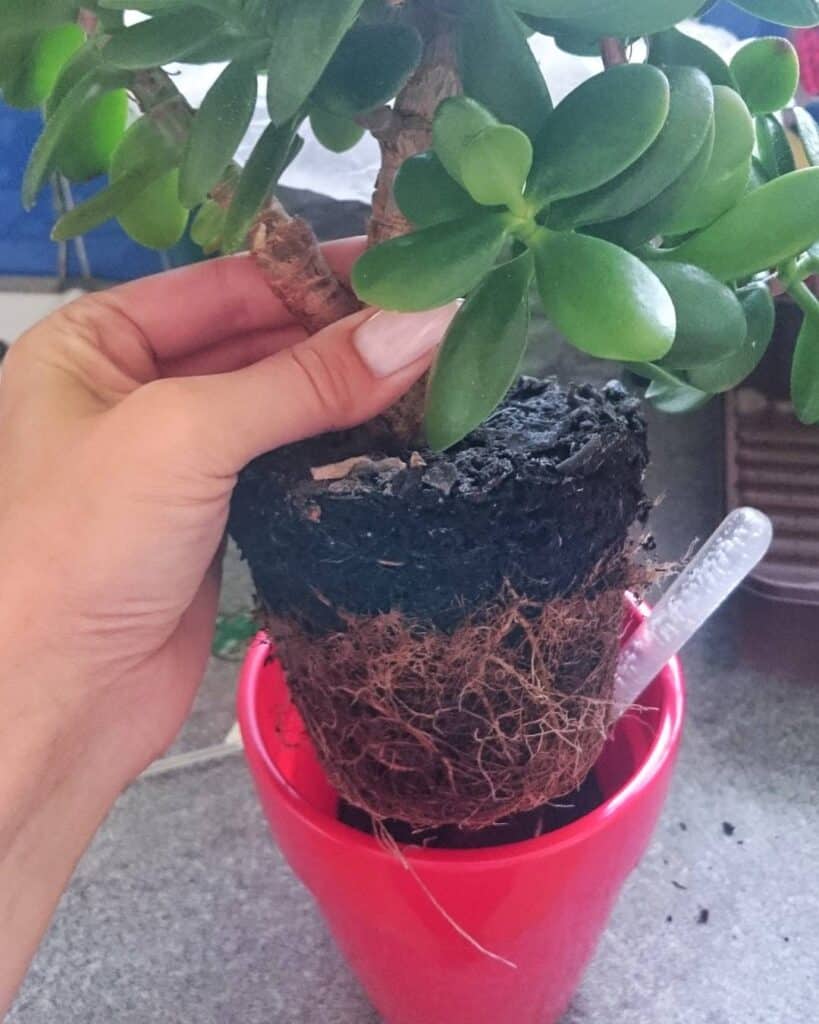A newbie in the planting community might have a misconception for repotting being a big task. Well, not really!
Repotting a Jade Plant is quite easy and helps your plant have a long sound life.
Besides, little tips and tricks can always help you excel in the process.
Table of Contents Show
Signs to Re-pot Jade Plant
Jade usually is less demanding when it comes to caring requirements. Even a garden novice would not have any issue fulfilling the light, temperature, fertilizer, and other basic needs.
Like any other plant, Jade shows signs of distress either due to overwatering, underwatering, or excess fertilizer.
Repotting is a common solution to address most of the plant’s problems.
- Root-bound conditions: Once the plants start outgrowing the pot, roots start peeking through the drain holes. This could elevate into the formation of cracks or crevices on the pot.

- Heavy bunch top: The top of the Jade plant becomes heavy, making it difficult for the pot to bear the weight. Pot may tumble down, causing plant injuries.
- Clumpy potting mix: Over time, the topsoil hardens with no pore space for aeration and moisture flow, obstructing the plant’s physiological activities. The substrate needs to be refreshed.
- Faded foliage: Leaves droop and appear yellow, failing to uptake nutrients due to hard soil and pot-bound conditions.
- Stunted growth: Plant loses its vigor due to depleted nutrients demanding the
What Soil Favors Jade Plant?
Like most succulents, Jade plants love some dryness around. It thrives in most soil as long as the drainage is sufficient.
Further, adding a little organic matter to the potting mix helps avoid tipping over the top heavy but shallow rotted plant.
You can curate the potting mix at home by incorporating 1 part of peat moss, 1 part of organic matter (fish manure)and three parts of coarse sand.
And if DIY hassle is not your cup of tea, the market has a wide spread of commercial potting mix.
Not just convenient, but the Jade Potting Soil Mix, Cacti & Succulent Mix, and Moisture Control Potting Mix are enriched with nutrients to suffice Jade’s requirements and save from any fertilizer issues.
Right-Sized Pot for Repotting
With over 1400 varieties of Jade, all differing in size, height, and spread, requires the pot accordingly.
Also, the superficial roots of Jade may not demand a big play space, but the bunch top needs structural support from the soil.
You may go for fancy decorative ceramic pots or traditional terracotta pots. Irrespective of the choice, ensure the pots have enough drain holes to avoid soggy soil.
When Should I repot my Jade Plant?
Your Jade plant would not mind being a little root bound. Rather it becomes more manageable.
But in the long run, that might cause an issue.
So, young Jade does fine when repotted once every 2 to 3 years.
On the contrary, Repot the older ones every 4 to 5 years for better root health and plant growth.
Moreover, frequent repotting of Jade would disturb its healthy growth.
Repotting Jade Plant
The onset of spring and the sign of your plants tell you the necessity of repotting.
Before we begin repotting the Jade Plant, equip yourself with a knife, a trowel, and a new pot.
- Drench the plant’s soil 2-3 days before being uprooted for easy operation.
- After loosening up the end with a knife, remove the plant from the pot. You may need to break the old pot in case uprooting becomes difficult, ensuring no harm to the roots.
- Gently shake the plants to clean all the soil bound to the root. The cleaner the root, the faster they grow to the new pot.
- Trim off any damaged and diseased plant for a healthy plant restart.
- Take a pot and fill an inch with the appropriate potting mix. Place the plant into the pot upright, spreading the remaining potting mix around the plant.
- Lightly press into the soil, and water thoroughly.
The plant might need a few days to a week to establish its new home.
Do not panic if the plant appears sick and droopy immediately after repotting. Let you Jade take sometime to adjust.
Taking Care of Jade Plant After Repotting
Repotting a Jade plant alone doesn’t free you from plant parent duty. Maintaining appropriate environmental conditions and adequate care for your plant plays equal significance in helping them adjust to its new home.
| Parameters | Favorable Condition |
|---|---|
| Light | No direct light for about a month. But Bright environment is most. |
| Temperature | 18° to 24°C/65° to 75°F 55°F / 13°C- During night and winter season |
| Watering | Little more watering during Spring and Summer. Little Less during Fall and Winter |
| Soil | Well draining soil with perlites |
| Humidity | Loves the humidity of 30%-50% |
Under optimal conditions, a mature Jade Plant might mesmerize you with white or pink blossoms.
Is Coffee Good for Jade Plants?
It’s proven scientifically and by experts that coffee can play an essential role in nourishing a jade plant only if used correctly.
However, unlike water applications, avoid directly spilling coffee over the plant.
A high concentration of caffeine makes the soil super acidic, slowing and gradually obstructing root formation and shoot development.
Pro Tip: Check the pH value of soil before adding coffee grounds to the soil since to avoid excess acidity in the soil.
Conclusion
Reptting allows your Jade to flourish only when the plant wants it and calls for help.
Pay a little attention to your green buddies and trust me, Jade will not disappoint you.

1 comment
Jade plants need repotting like all other indoor plants to achieve the healthiest growth and expand their roots.do this task every two years and when the succulent has outgrown its pot.